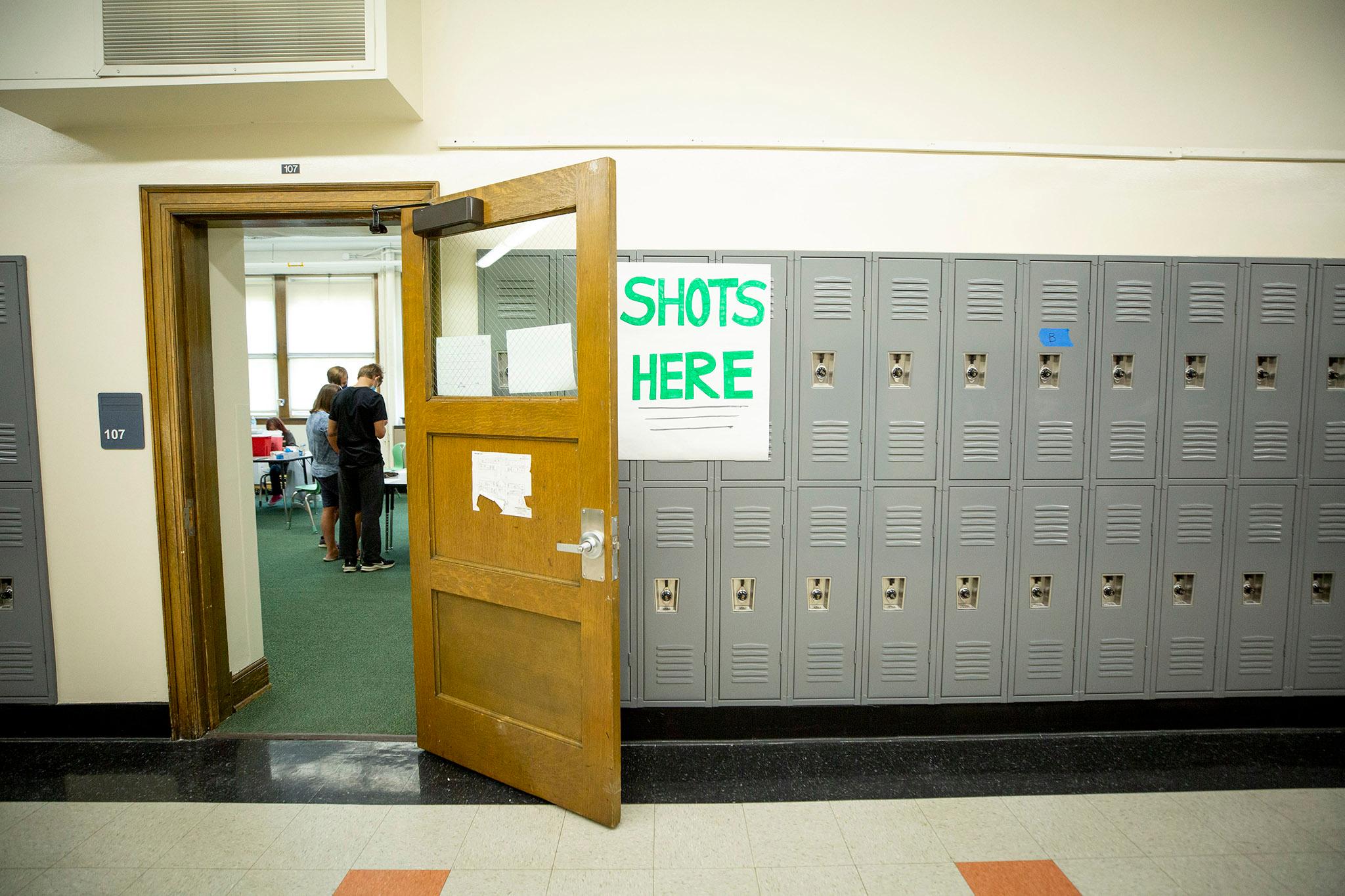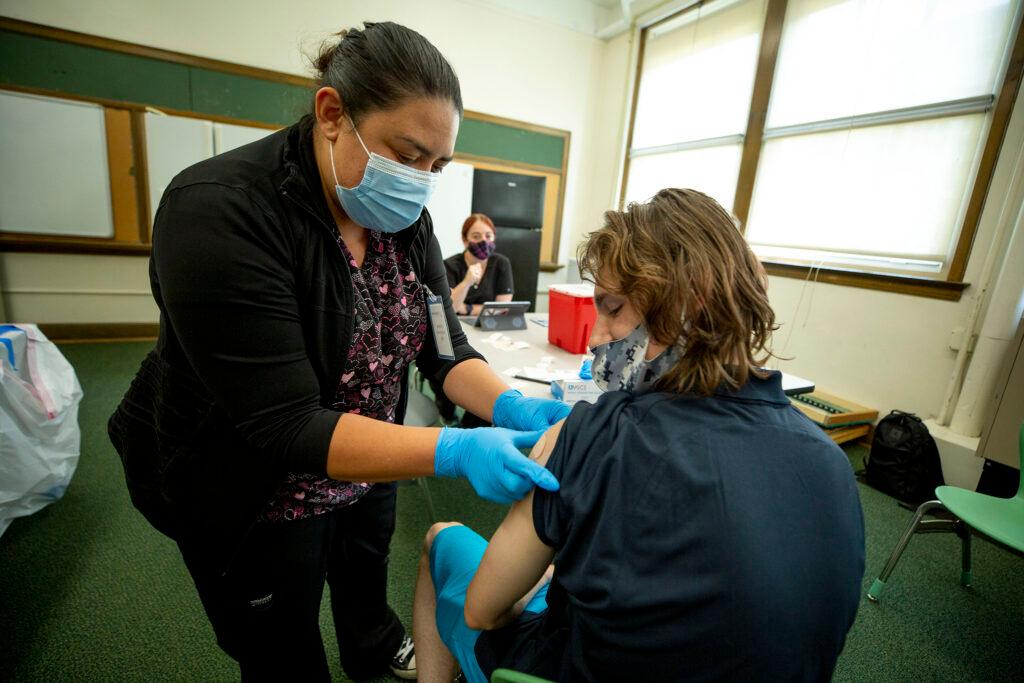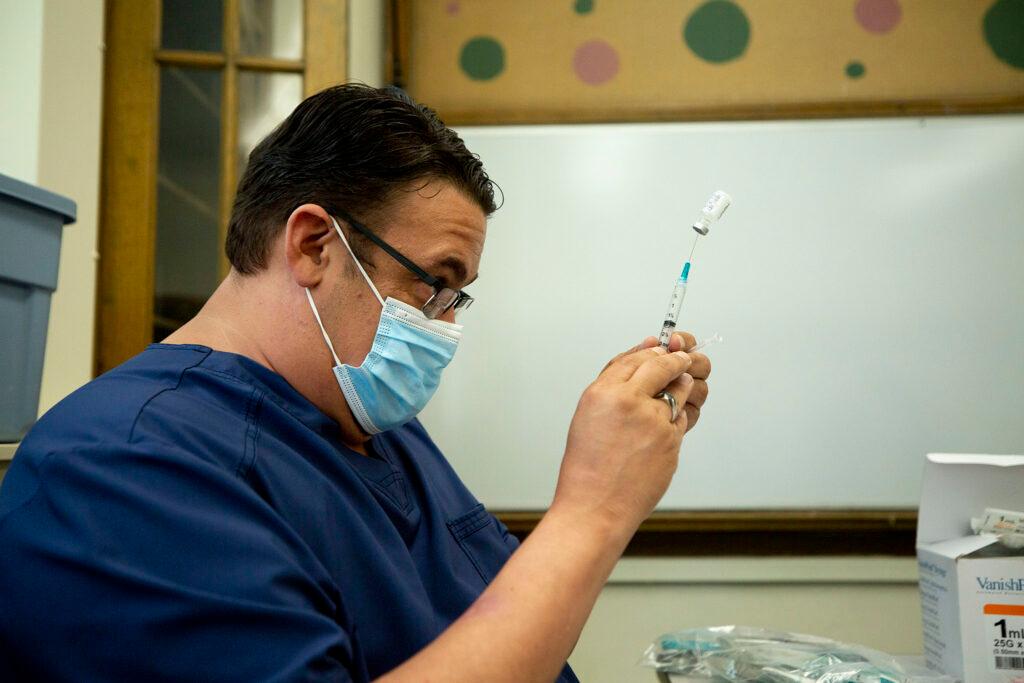
School starts this week in Mesa County on Colorado’s Western Slope. And mom Kaylan Robinson is anxious, unsure if she’s ready to send her five-year-old Louis off to kindergarten.
“Kids 11 and under don't have that choice to get vaccinated right now. And I feel like it's very obvious that our community is at high risk,” Robinson said. She said she was “shocked and disappointed,” to learn the Mesa County Valley School District would not be requiring masks “to protect each other, to ensure that schools can stay in session.”
Nearly a year and half into the pandemic, some public health experts and doctors are uneasy too, with a highly contagious delta variant racing through unvaccinated populations. They worry some schools could reopen to in-person learning only to return to remote learning when fresh outbreaks take hold. But in some areas, local and public leaders, many who’ve faced protests and threats through the crisis, wonder if adults and kids would comply with renewed mask mandates anyway.
That has created a mish-mash of school district policies across the state. In the absence of orders from state and local health authorities, the hard decisions are in the hands of local school officials — the people most likely to be stopped in a grocery store aisle and challenged on whatever rules they choose to impose.
The result: while the same virus is circulating everywhere, school preparations for it vary considerably. In Denver, where a health order was issued, all school workers, including teachers, will have to be vaccinated and everyone in a school building will wear a mask. In Mesa, everything from vaccinations to face coverings is up to the individual. Both places are currently classified as having “high” or “very high” rates of transmission by the state, though Denver’s is marginally lower than Mesa’s.
COVID-19 safety measures vary across districts
In Aurora Public Schools, situated in counties with moderate-to-high vaccination rates and high and very high transmission of COVID-19, they are going with a hybrid: masks are optional for vaccinated staff and unvaccinated staff and students are simply encouraged to cover up. Mandatory vaccines are possible for staff, but only after federal authorities grant full authorization for their use, rather than the current emergency authorization.

“I think parents are very confused,” said Staci Ruddy, president of Colorado PTA, which has 19,000 members statewide and hasn’t taken a formal position on back-to-school guidelines. She noted in the last few days, school districts in Denver, Jefferson and El Paso counties have all come out with statements about masking and vaccine guidelines in school, “and they're all three different. So it's certainly confusing for parents, especially if you have a kid in more than one school district.”
The permutations are almost endless.
In the Adams 5-star district, where the vaccination rate is moderate, and the COVID-19 transmission levels are very high, masks will be mandatory for staff and optional for students.
On the other side of the metro area, Jefferson County has a high vaccination rate and a high transmission. There, masks are required for students ages 3-11 and optional for others. Masks are required for unvaccinated staff and optional for others. The county’s public health director said she thinks most JeffCo residents will come to understand the need to protect unvaccinated kids against the spreading delta variant.
Up in the mountains of central Colorado, in Eagle County, the vaccination rate is high (one of the top five in the state), but transmission is now high as well. Face coverings and vaccines are not required there for staff or students. On the school district’s website, with details of this year’s guidance, it reads, “it is our desire to return our schools to ‘pre-pandemic normal.’”
But everyone, everywhere, has to wear a mask on the school bus.
For some parents, the uneven guidelines are dizzying and troubling.
Robinson, from Palisade, said she worries her son could pick up the virus, about the health of her 10-month-old, and about the virus spreading to others, like the mother of a friend, who are immunocompromised and more vulnerable.
“My husband and I are vaccinated and we still wear our masks out in public. I have to think about my baby, who may or may not have antibodies, because I'm nursing him still,” she said. “You think about getting all those kids back together, potentially without masks, just the repercussions of that come home.”
She’s not the only one feeling that angst. Robinson and a friend formed a group a couple of weeks ago called SOS, Supporters for Schools Opening Safely. Since then, more than 450 people have signed a petition the group is circulating. It asks the district to reconsider its approach: to promote vaccination of students and staff and require universal face masks for students, staff, and visitors entering any School District 51 school building until vaccines become accessible to school-aged children.
Grand Junction grandparents Beth and Aaron Long also back the petition. They’re concerned about their 8-year-old grandson Jonah and are urging the district to follow the recommended guidelines of the American Academy of Pediatrics. The nation’s pediatricians recommend in-person learning and masks for everyone older than two, regardless of vaccination status. Its “multi-pronged” approach also emphasizes other things like ventilation, testing and quarantining.
“These little guys are the most vulnerable,” said Beth Long. Her grandson is “not an experiment. It (masking) needs to happen so that we know he can be safe.”
Voluntary rather than mandatory mask wearing opens the door to kids who wear masks being hassled for it, said Aaron Long. He said it’s something a uniform policy would prevent.
“I think having children make a decision to wear a mask or not, it's going to be very difficult,” he said. “I think one of the concerns we have is our grandson being bullied for wearing his mask, when so many other kids aren’t,” an issue his grandson had already encountered in playgroups.
But a school mask requirement in Mesa County, backed up by a statewide mask mandate in schools, wore thin last spring. A group of parents and students organized a walk-out in protest. One parent told KKCO “here in Mesa County, we are free to choose except for our students.” Another said “they do not allow the kids to even take off the mask when they’re sitting at their desks. I don’t see the need for that.”
Outbreaks will happen with schools reopening as another COVID wave hits
As cases start to rise around the country and Colorado as well, families have “more questions and more anxiety,” said Dr. Jessica Cataldi, a pediatrician and infectious disease specialist with Children’s Hospital Colorado. “The heart of it is really how to keep their kids safe.” She urged parents to advise their children to wear masks in crowded indoor spaces, like schools, even if their school district doesn’t require it.
“We will see school outbreaks, that will certainly happen. And the question is just how many and how big,” said Cataldi, who noted that’s already happening in the South, where vaccination rates are low and virus cases and hospitalizations have been rising quickly. Especially with other bugs also resurging, like the respiratory virus RSV, Cataldi said “it’s going to be a messy fall.”
On Tuesday, the American Academy of Pediatrics reported nearly 72,000 children and teens caught COVID-19 last week -- a "substantial" increase of 39,000, or 84%, from a week earlier. The group noted “at this time, it appears that severe illness due to COVID-19 is uncommon among children.”
But severe illness in young people, though rare, does happen. To date, there have been 15 deaths among cases of COVID-19 in Coloradans between the ages of 0 and 17. Three of those victims were in the 0-9 age group, and 12 were in the 10-17 age group. “Deaths among cases” is an epidemiological metric that counts deaths that occurred within 30 days of a positive COVID-19 diagnosis; they cannot necessarily be attributed to COVID-19.
Since the start of the pandemic, there have been 800 COVID-19 hospitalizations among children in Colorado. Of those, 352 are among kids up to age 9, and 448 fall into the 10-17 age group.
The timing of school reopening in Colorado, as the state seems to be experiencing yet another wave of COVID-19, almost entirely driven by unvaccinated residents, adds a layer of concern.
“This is a very precarious time in the pandemic and schools are opening up in the middle of it. It is important that schools reopen but we should do everything we can to assure that children are safe,” said Dr. John Swartzberg, a clinical professor emeritus and expert in infectious diseases at the UC Berkeley School of Public Health, who has been following Colorado’s course and response to the pandemic. “Masking in schools is an important way to help maximize their safety.”
Mask decisions have been controversial in many places. In JeffCo, parents protesting mandatory masks for the youngest students showed up at the county’s public health office Wednesday chanting “my body, my choice.” In Mesa, the district has heard complaints from all sides. Mesa County Valley Superintendent Diana Sirko told the Daily Sentinel the district’s decision was made after consulting county health officials.
“They were certainly comfortable with us starting with masks not being required but were very clear that at any time that could change,” Sirko said.
Breakthrough cases among the vaccinated are changing mask rules
In July, the Centers for Disease Control and Prevention changed its mask guidance, recommending even vaccinated people in most places wear masks indoors. The CDC recommends students, teachers and staff wear masks, regardless of vaccination status.
Breakthrough cases are rare, but the CDC said vaccinated people can still spread the virus if infected. Hospitalization rates among breakthrough cases also are still low, but going up.
Most Colorado counties fall under the CDC’s new masking guidance, but the state has so far not issued a new mask mandate, instead urging vaccination. That is not now an option for children younger than 12, and it’s unknown when the federal government will authorize it.
“A statewide mask requirement would be an extraordinary step,” Gov. Jared Polis said Monday, noting hospital capacity was in much better shape than when he issued such a requirement last year. “It was one that we didn't hesitate to take when our hospital capacity was in jeopardy and that we sought to remove the minute we reached the conclusion that our hospital capacity was no longer in jeopardy. It's not the type of step that is normally appropriate in non-emergency circumstances.”
But with the Delta variant spreading, other governors have had to change course. Illinois Gov. J.B. Pritzker, a Democrat, on Wednesday announced all students and teachers in schools will be required to wear masks while indoors. He said the move was made to try to slow the spread of the delta variant of COVID-19.
Hospitalizations for patients with confirmed COVID-19 cases have risen steadily over the last three weeks, after hitting a 10-month low of 261 in mid-July. As of August 3, the number stands at 383. Polis said this week if the state can't reach 80% vaccination rates, the outlook will get worse, and the state could see virus hospitalizations as high as 900 patients. That’s roughly double where Colorado is now, and would be the highest the state has seen in months, but lower than the peak of nearly 2,000 late last year. “We expect it to get worse before it gets better,” he said.
In some larger counties with relatively low vaccination rates, like El Paso (62 percent of eligible population with at least one shot), Weld (59 percent) and Pueblo (57 percent), school districts also said they wouldn’t require masks, make them optional, or were still mulling it over. Some leaders worried about enforcement and compliance.
“Is it going to be effective? Is the (community's) will there to follow it?” Pueblo public health director Randy Evetts asked the county’s board of health, according to the Pueblo Chieftain.
“And knowing we don’t have the ability to enforce it, is it truly something worth pushing out there in terms of a public health order? Or do we approach it more from a recommendation standpoint?”
On Wednesday, Pueblo’s school district announced, “in alignment with local and state guidance,” face coverings will be strongly encouraged while learning indoors, but will not be required for now.
Another key public health department, Tri-County, which includes Adams, Arapahoe and Douglas County, strongly urged but did not require masks in public indoor settings. For Aurora Public Schools that meant unvaccianted employees would be required to wear masks, but there was no mandate, and instead a strong recommendation for unvaccinated students to wear masks.
Like many in other public health departments, the agency’s top leader said he hoped the position would spur vaccination.
“‘We strongly urge you to do it’ will not necessarily mean that everybody will do it. And if we end up seeing rates continuing to rise and not seeing vaccine rates go up, I don't think mandating masking is out of the question,” said Dr. John Douglas, Jr., Tri-County’s executive director. “But honestly I'd much rather see us sort of through voluntary measures get vaccination to increase. Cause that's the name of the game.”
State's vaccination numbers showing signs of revival
The state’s vaccination numbers, though down from the 400,000-shots-a-week peaks of the spring, are showing modest signs of revival. The last week of July the 7-day figure rose to more than 55-thousand, the second consecutive week of increases after more than a month of declines.
The increase came as a growing number of health systems, governments and businesses nationally, and some locally, announced new vaccine mandates for employees and patrons.
The health department in Weld County, which resisted state COVID-19 guidance earlier in the pandemic, on Tuesday reported a considerable increase in vaccinations over the past several weeks. It cited varied possible reasons for the hike: school starting soon, employer requirements, and the emerging Delta variant. The county said it would be expanding free vaccine clinics at libraries.

“We are getting close to reaching 60 percent of Weld residents getting at least one dose,” said Mark Lawley, Executive Director of the Weld County Department of Public Health and Environment, in a release. The county is looking to reach at least 70% or higher within the next few months.
Ruddy of the PTA said virtually across the board, parents she’s spoken with want kids back in school in-person. And many worry outbreaks could drive students back to remote learning once again this year. “That's probably their number one fear,” she said. “It was such a challenge on the kids from a learning perspective.”
Mesa County parent Kaylan Robinson applauded districts that have made the tough call to issue mask requirements, and sympathized with school and public health leaders who face heat from both sides.
But in her view, with the more transmissible Delta variant on the rise, the risk of an elementary kid catching COVID-19 and dying, or multiple kids being hospitalized, is worth the inconvenience of masking.
“Ideally we're all safe until we all have the choice of a vaccination,” she said.
- A Respected Denver Doctor Ends Her Practice, But She’s Not Done Serving Her Community
- Colorado Schools Divided Over Health Experts’ Advice To Mask Up Again
- Masks in Colorado: The CDC Says Masks Should Be Worn Indoors In These Counties
- As The Delta Variant Continues To Spread Among Colorado’s Unvaccinated, Some Wonder If Vaccine Mandates Could Ever Happen — And If They’d Work







